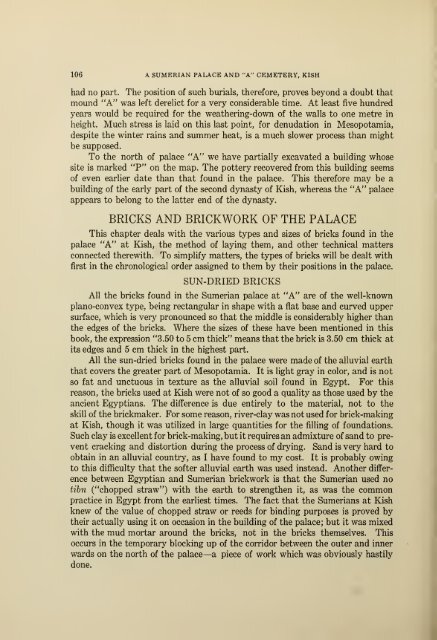A Sumerian Palace and the "A" cemetery at Kish, Mesopotamia
A Sumerian Palace and the "A" cemetery at Kish, Mesopotamia
A Sumerian Palace and the "A" cemetery at Kish, Mesopotamia
Create successful ePaper yourself
Turn your PDF publications into a flip-book with our unique Google optimized e-Paper software.
106 A SUMERIAN PALACE AND "A" CEMETERY, KISH<br />
had no part. The position of such burials, <strong>the</strong>refore, proves beyond a doubt th<strong>at</strong><br />
mound "A" was left derelict for a very considerable time. At least five hundred<br />
years would be required for <strong>the</strong> wea<strong>the</strong>ring-down of <strong>the</strong> walls to one metre in<br />
height. Much stress is laid on this last point, for denud<strong>at</strong>ion in <strong>Mesopotamia</strong>,<br />
despite <strong>the</strong> winter rains <strong>and</strong> summer he<strong>at</strong>, is a much slower process than might<br />
be supposed.<br />
To <strong>the</strong> north of palace "A" we have partially excav<strong>at</strong>ed a building whose<br />
site is marked "P" on <strong>the</strong> map. The pottery recovered from this building seems<br />
of even earlier d<strong>at</strong>e than th<strong>at</strong> found in <strong>the</strong> palace. This <strong>the</strong>refore may be a<br />
building of <strong>the</strong> early part of <strong>the</strong> second dynasty of <strong>Kish</strong>, whereas <strong>the</strong> "A" palace<br />
appears to belong to <strong>the</strong> l<strong>at</strong>ter end of <strong>the</strong> dynasty.<br />
BRICKS AND BRICKWORK OF THE PALACE<br />
This chapter deals with <strong>the</strong> various types <strong>and</strong> sizes of bricks found in <strong>the</strong><br />
palace "A" <strong>at</strong> <strong>Kish</strong>, <strong>the</strong> method of laying <strong>the</strong>m, <strong>and</strong> o<strong>the</strong>r technical m<strong>at</strong>ters<br />
connected <strong>the</strong>rewith. To simplify m<strong>at</strong>ters, <strong>the</strong> types of bricks will be dealt with<br />
first in <strong>the</strong> chronological order assigned to <strong>the</strong>m by <strong>the</strong>ir positions in <strong>the</strong> palace.<br />
SUN-DRIED BRICKS<br />
All <strong>the</strong> bricks found in <strong>the</strong> <strong>Sumerian</strong> palace <strong>at</strong> "A" are of <strong>the</strong> well-known<br />
plano-convex type, being rectangular in shape with a fl<strong>at</strong> base <strong>and</strong> curved upper<br />
surface, which is very pronounced so th<strong>at</strong> <strong>the</strong> middle is considerably higher than<br />
<strong>the</strong> edges of <strong>the</strong> bricks. Where <strong>the</strong> sizes of <strong>the</strong>se have been mentioned in this<br />
book, <strong>the</strong> expression "3.50 to 5 cm thick" means th<strong>at</strong> <strong>the</strong> brick is 3.50 cm thick <strong>at</strong><br />
its edges <strong>and</strong> 5 cm thick in <strong>the</strong> highest part.<br />
All <strong>the</strong> sun-dried bricks found in <strong>the</strong> palace were made of <strong>the</strong> alluvial earth<br />
th<strong>at</strong> covers <strong>the</strong> gre<strong>at</strong>er part of <strong>Mesopotamia</strong>. It is light gray in color, <strong>and</strong> is not<br />
so f<strong>at</strong> <strong>and</strong> unctuous in texture as <strong>the</strong> alluvial soil found in Egypt. For this<br />
reason, <strong>the</strong> bricks used <strong>at</strong> <strong>Kish</strong> were not of so good a quality as those used by <strong>the</strong><br />
ancient Egyptians. The difference is due entirely to <strong>the</strong> m<strong>at</strong>erial, not to <strong>the</strong><br />
skill of <strong>the</strong> brickmaker. For some reason, river-clay was not used for brick-making<br />
<strong>at</strong> <strong>Kish</strong>, though it was utilized in large quantities for <strong>the</strong> filling of found<strong>at</strong>ions.<br />
Such clay is excellent for brick-making, but it requires an admixture of s<strong>and</strong> to prevent<br />
cracking <strong>and</strong> distortion during <strong>the</strong> process of drying. S<strong>and</strong> is very hard to<br />
obtain in an alluvial country, as I have found to my cost. It is probably owing<br />
to this difficulty th<strong>at</strong> <strong>the</strong> softer alluvial earth was used instead. Ano<strong>the</strong>r difference<br />
between Egyptian <strong>and</strong> <strong>Sumerian</strong> brickwork is th<strong>at</strong> <strong>the</strong> <strong>Sumerian</strong> used no<br />
tibn ("chopped straw") with <strong>the</strong> earth to streng<strong>the</strong>n it, as was <strong>the</strong> common<br />
practice in Egypt from <strong>the</strong> earliest times. The fact th<strong>at</strong> <strong>the</strong> <strong>Sumerian</strong>s <strong>at</strong> <strong>Kish</strong><br />
knew of <strong>the</strong> value of chopped straw or reeds for binding purposes is proved by<br />
<strong>the</strong>ir actually using it on occasion in <strong>the</strong> building of <strong>the</strong> palace; but it was mixed<br />
with <strong>the</strong> mud mortar around <strong>the</strong> bricks, not in <strong>the</strong> bricks <strong>the</strong>mselves. This<br />
occurs in <strong>the</strong> temporary blocking up of <strong>the</strong> corridor between <strong>the</strong> outer <strong>and</strong> inner<br />
wards on <strong>the</strong> north of <strong>the</strong> palace—a piece of work which was obviously hastily<br />
done.

















